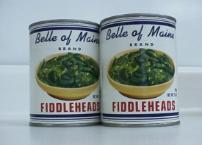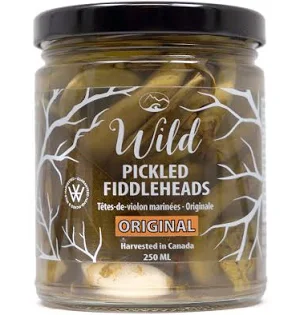Vera Longtoe Sheehan
This article was originally printed in the Abenaki Newsletter, “The Voice of the Turtle”
in 1997. However, it has been slightly revised to include current locations to purchase fresh Fiddleheads.


For hundreds of years, possibly longer, Wabanaki women have spent cool spring mornings harvesting fiddleheads. Today Fiddleheads can still be found growing alongside streams, riverbanks, and wooded areas in New York, throughout New England, and up to Nova Scotia. For those of you, who are not familiar with Fiddleheads, they are the coiled heads of fern fronds. They are easily gathered and prepared in a variety of ways, from everyday home cooking to being used as a gourmet garnish. However, as with any good thing, there are always precautions to beware of.
My father once told me that Fiddleheads pop up at the same time as the dandelions are budding. It usually starts in May and ends in June. They are commonly harvested by snapping off the head and one or two inches of stem. Once the coiled fern leaf opens, it is too late to harvest. Preparation is easy. Remove the chaff (brown papery-looking covering), cut off any excess stem, rinse thoroughly to remove any dirt, and blanch in boiling water for about 2 minutes.
Fiddleheads are crunchy and taste something like a mix between spinach and asparagus. They taste best when served fresh and can be eaten: as a hot, steamed or boiled dish served with butter; as a cold dish, by refrigerating them after blanching; as a garnish on a garden salad or in a bowl of hominy. You can refrigerate them for up to 2 or 3 days. If you wish to freeze your Fiddleheads, blanch them in boiling water and dry them, before placing them in the freezer.
About ten years ago, I was fortunate enough to take a class on edible Native plants with Native Ethno-botanist and food historian, E Barrie Kavasch. She strongly advised eating Fiddleheads in moderation because certain ones have been known to cause thiaminase poisoning in livestock. She also cautioned against eating them raw. The CDC has even done research into illnesses that were caused by eating Fiddleheads in Europe.
If you plan to forage Ostrich Fiddleheads please do your research to learn how to identify them and their poisonous twin. Read more about Fiddlehead Safety from the University of Maine, Bulletin #4198.
For those of you, who are unable to harvest your own Fiddleheads and would like to try them. They are available fresh at many Hannaford, Whole Foods, Trader Joe’s Supermarkets, and Pacific Wild Pick, or can be ordered seasonally from Dean & Delucca in New York City. I have provided links to buy Fiddleheads in a can or jar.
Fiddleheads & Rice
Bear Fat (substitutes – butter, oil, beef or pork fat)
1 cup Fiddleheads
1 cup rice
½ cup chopped wild or white onion
½ cup chopped mushrooms
1 chopped clove of garlic
Salt & Pepper to taste
Rinse and blanch the Fiddleheads. Rinse 1 cup wild rice. Boil rice with 3 cups of
water. Let rice simmer for 20-25 minutes. Fluff with fork and set aside. Sauté
Fiddleheads, onions, mushrooms, and garlic. Then toss the wild rice and veggies
together.
Makes approximately 4-6 servings.
Honey Vinegar Fiddleheads
3 cups Fiddleheads
½ cup birch sap vinegar or cider vinegar
3 tbs. Honey
Rinse and blanch the Fiddleheads. Mix Fiddleheads with the vinegar and honey.
Marinade for about an hour, mixing occasionally. Refrigerate and serve.
Makes 4 ½ cups servings.



